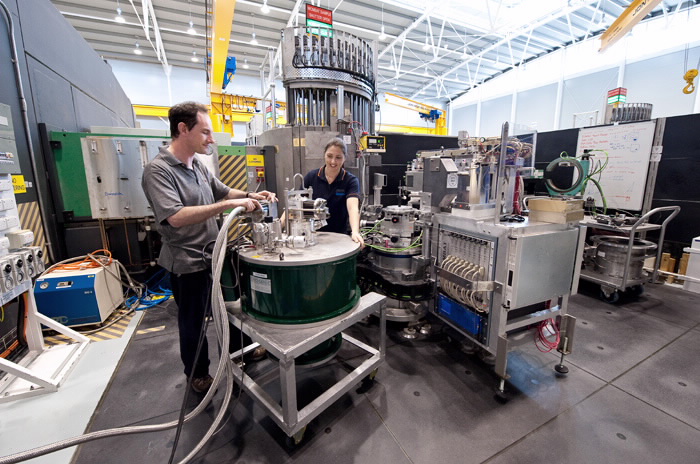In theory, lithium batteries should run forever providing an infinite power source for our electronic devices and potentially one day - electric cars. The problem is a number of factors inhibit their performance. ANSTO's research using neutron diffraction is looking into this issue to help improve their shelf life.
Introduction
 |
| Electronic Devices |
Most Australians own at least one Li-ion battery, usually in a mobile device, such as a mobile phone, portable media player, or a laptop computer. Soon Australians may be driving electric vehicles powered by Li-ion battery technology.
Our research uses neutron diffraction to learn what happens to the molecular-scale structure of components within Li-ion batteries during use and re-charge.
We explore crystallographic features with respect to electrochemical properties and the mechanism of charge-transfer, in order to improve our understanding of the electrochemical performance of batteries. Here, we present some work undertaken with in situ and ex situ neutron diffraction on the instruments Wombat and Echidna, respectively, at the OPAL research reactor.
How do Li-ion batteries work?
We chose to investigate Li-ion batteries because of their current technological applications and due to their higher energy densities relative to other battery systems such as Ni-MH and Ni-Cd.
Commercialisation of the first Li-ion battery began in the early 1990’s in the form of a LiCoO2 cathode and a graphite anode.
During charging, electricity is drawn into the battery from a power-point. The electrons induce a series of chemical reactions where positively charged Li-ions are transferred from the cathode material, via an electrolyte, to the anode material as a consequence.
During use of a battery (discharge) the reverse occurs and Li-ions are transferred back from the anode to the cathode, and electrons are provided to an external circuit, allowing us to power devices by using the stored electricity.
The relatively high energy-density of the Li-ion battery is a result of the low atomic mass of Li atoms and the ease at which Li can be transported into and out of electrodes and through electrolytes [1].
Presently, Li-ion battery research is focused on materials that show favourable electrochemical properties including investigations into new high-voltage cathode and low-voltage anode materials in order to enable the maximum voltage output.
For example, combining LiCoO2 and graphite produces a 3.7 V battery, while combining LiMn2O4 and graphite produces a 4.5 V battery [2].
However, the practicality of a battery is not limited to its maximum voltage output.
Other factors that play a significant role in the useability of a battery include its ability to be re-charged and discharged thousands of times, its Li capacity, as well as the safety and environmental implications of the battery components.
What can neutron diffraction do for this research?
Neutrons are useful in Li-ion battery research as a result of their high sensitivity towards Li in comparison to other probes of matter such as X-rays.
Furthermore, neutrons are highly penetrating, so the bulk materials are sampled rather than their surfaces.
Using neutrons we can study whole commercially available batteries in situ.
Examples of batteries we have evaluated in charge-discharge cycles are shown in Fig. 1 [See images below]. There are two types of experiments that we routinely undertake using Echidna, the high-resolution powder diffractometer [3], and Wombat, the high-intensity powder diffractometer [4], and these are outlined below.
Wombat experiments
 |
| The Wombat Instrument |
In situ experiments undertaken on Wombat provide a method to directly link real-time changes in the crystal-structure of materials inside a battery to the electrochemical state of the battery.
The compromise made to gain in situ capability comes in the form of our ability to resolve the structure of the battery components accurately. To help mitigate this, we use structural models determined ex situ (with Echidna) as a starting point and modify these as necessary to observe the affect of electrochemical activity (charge or discharge).
This approach has been used successfully to determine what happens to the electrode structures in a commercial Li-ion battery [5] during its use. In the discharged state, the anode consists of graphite, and as the battery was charged Li was inserted into the graphite resulting in an expansion of the anode.
This is observed by the reduction in the measured 2θ value of the (002) reflection for graphite shown in Fig. 2. The (002) reflection was found not to decrease in a continuous way during charging, but instead we find that the reflection position stabilises somewhat, before the relatively fast formation of a second phase, LiC6.
This indicates that the Li insertion mechanism into graphite does not correspond to a continuous linear expansion of graphite. One possible explanation for this behaviour is the formation of a surface layer that traps Li, inhibiting the flow of Li into the graphite.
Another possibility is that the first Li-ions inserted into graphite cause expansion of the material and the remaining Li-ions fill in the gaps. These possibilities will be investigated in future experiments.
At the cathode, which was composed of two types of LiCoO2, a series of reactions took place during charge-discharge of the battery, as shown in Fig. 3.
Using in situ neutron diffraction we identified each phase as they changed with Li insertion and extraction (see top panels of Fig. 3) and followed these changes qualitatively through changes occurring to the lattice parameters of the crystal structure for each phase (corresponding to different forms of LiCoO2).
We identified two reaction mechanisms for Li insertion. The first mechanism is solid-solution behaviour where Li is inserted and the lattice parameters increase or decrease to accommodate this.
The second mechanism is two-phase behaviour where the first phase transforms into the second phase during Li insertion (see the regions labelled I+II and A+B in the top panels of Fig. 3).
Echidna experiments
 |
| The Echidna Instrument |
Typically ex situ experiments are undertaken on Echidna, where we obtain high accuracy crystal-structure information. We can dope materials with a variety of cations and anions, aimed at improving the electrochemical performance of the material, and investigate how these dopants alter the material’s structure.
Since the structural changes can be related to changes in the electrochemical performance (as measured using batteries assembled from these components) we can determine whether there is a structural reason why some of these materials show better electrical performance.
Another experimental approach using Echidna is to assemble an electrode and battery from the material after we have obtained high precision structural information.
This way we can charge or discharge the electrode and then extract the electrode material from the battery and re-analyse it using Echidna to structurally characterise it in a different electrochemical state.
This approach is problematic as reactions can occur to the material during its extraction from the battery resulting in changes to its structure, limiting the validity of the relationship of the material’s structure to its electrochemical state.
Next steps
Our present focus is to develop designs for in situ electrochemical cells that resemble commercially available batteries but provide increased neutron-scattering signals from materials of interest.
Using this approach we hope to gain more accurate structural information that will enable us to track Li in both known (as reported here) and new electrode materials (for which the crystal structures have not been previously characterised).
This is important as our in situ experiments have revealed transformation of electrode materials during battery operation to phases with crystal structures that are, at present, unknown.
Authors
Neeraj Sharma and Vanessa K. Peterson
References
[1] Tarascon, J. –M., & Armand, M. (2001). Issues and challenges facing rechargeable lithium batteries. Nature, 414, 359-367.
[2] Guyomard, D., & Tarascon, J. M. (1994). The carbon/Li1+xMn2O4 system. Solid State Ionics, 69(3-4), 222-237.
[3] Studer, A. J., Hagen, M. E., & Noakes, T. J. (2006). Wombat: The high-intensity powder diffractometer at the OPAL reactor. Physica B: Condensed Matter, 385-386(2), 1013-1015.
[4] Liss, K. D., Hunter, B., Hagen, M., Noakes, T., & Kennedy, S. (2006). Echidna—the new high-resolution powder diffractometer being built at OPAL. Physica B: Condensed Matter, 385-386(2), 1010-1012.
[5] Sharma, N., Peterson, V. K., Elcombe, M. M., Avdeev, M., Studer, A. J.,Blagojevic, N., et al. (2010). Structural changes in a commercial lithium-ion battery during electrochemical cycling: An in situ neutron diffraction study. Journal of Power Sources, 195(24), 8258-8266.
[6] Rietveld, H. M. (1969). A profile refinement method for nuclear and magnetic structures. Journal of Applied Crystallography, 2(2), 65-71.
[7] Young, R. A. (1993). The Rietveld Method. Chester, United States of America: Oxford University Press. 312p.
Published: 06/03/2011


